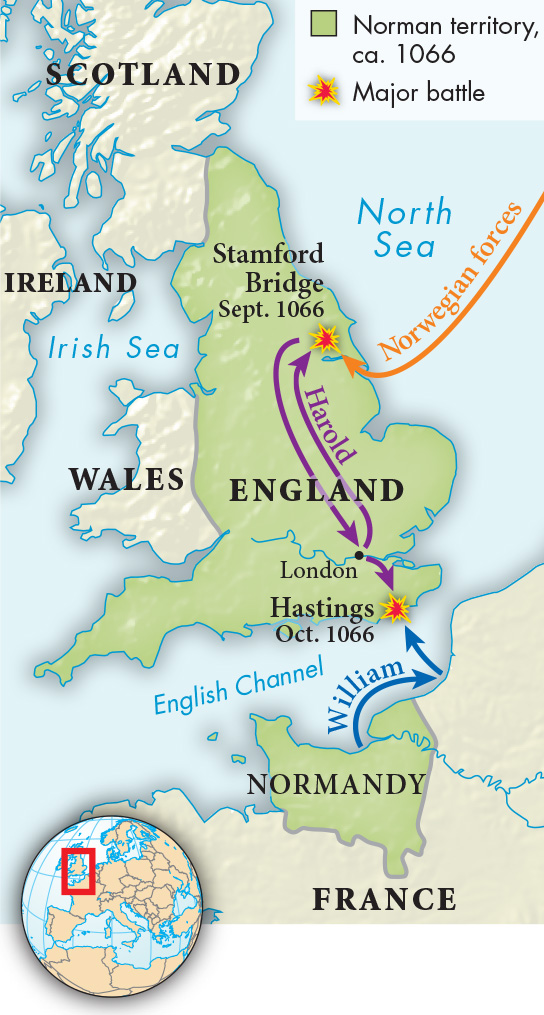The Restoration of Order

The Norman Conquest, 1066
The eleventh century witnessed the beginnings of political stability in western Europe. Foreign invasions gradually declined, and in some parts of Europe lords in control of large territories built up their power even further, becoming kings over growing and slowly centralizing states. In a process similar to that occurring at the same time in the West African kingdom of Ghana (see “The Kingdom of Ghana, ca. 900-–1100” in Chapter 10), rulers expanded their territories and extended their authority by developing larger bureaucracies, armies, judicial systems, and other institutions to maintain control, as well as taxation systems to pay for them. These new institutions and practices laid the foundations for modern national states. Political developments in England, France, and Germany provide good examples of the beginnings of the national state in the central Middle Ages.
Throughout the ninth century the Vikings made a concerted effort to conquer and rule all of Anglo-Saxon England, and in the early eleventh century they succeeded. The Viking Canute (r. 1016–1035) made England the center of his empire, while promoting a policy of assimilation and reconciliation between Anglo-Saxons and Vikings. At the same time, England was divided into local shires, or counties, each under the jurisdiction of a sheriff appointed by the king. When Canute’s heir Edward died childless, there were three claimants to the throne. One of these, Duke William of Normandy, crossed the Channel and won the English throne by defeating and killing his Anglo-Saxon rival, Harold II, at the Battle of Hastings in 1066. Later dubbed “the Conqueror,” William (r. 1066–1087) limited the power of the nobles and church officials and built a unified monarchy. He retained the Anglo-Saxon institution of sheriff, but named Normans to the posts.
In 1085 William decided to conduct a systematic survey of the entire country to determine how much wealth there was and who had it. This process was described by a contemporary chronicler:
He sent his men over all England into every shire and had them find out . . . what or how much everybody had who was occupying land in England, in land or cattle, and how much money it was worth. So very narrowly did he have it investigated, that there was no single . . . yard of land, nor indeed . . . one ox nor one cow nor one pig was there left out, and not put down in his record: and all these records were brought to him afterwards.1
The resulting record, called the Domesday Book (DOOMZ-day) from the Anglo-Saxon word doom, meaning “judgment,” provided William and his descendants with vital information for governing the country. Completed in 1086, the book still survives, and it is an invaluable source of social and economic information about medieval England.
In 1128 William’s granddaughter Matilda married a powerful French noble, Geoffrey of Anjou. Their son, who became Henry II of England, inherited provinces in northwestern France from his father. When Henry married the great heiress Eleanor of Aquitaine in 1152, he claimed lordship over Aquitaine and other provinces in southwestern France as well. The histories of England and France were thus closely intertwined in the Middle Ages.
In the early twelfth century France consisted of a number of nearly independent provinces, each governed by its local ruler. The work of unifying and enlarging France began under Philip II (r. 1180–1223), also known as Philip Augustus. By the end of his reign Philip was effectively master of northern France, and by 1300 most of the provinces of modern France had been added to the royal domain through diplomacy, marriage, war, and inheritance.
In central Europe the German king Otto I (r. 936–973) defeated many other lords to build up his power, based on an alliance with and control of the church. Otto asserted the right to control church appointments, and bishops and abbots had to perform feudal homage for the lands that accompanied their church positions. Under Otto I and his successors, a loose confederation stretching from the North Sea to the Mediterranean developed. In this confederation, later called the Holy Roman Empire, the emperor shared power with princes, dukes, counts, city officials, archbishops, and bishops.
Frederick Barbarossa (r. 1152–1190) of the house of Hohenstaufen tried valiantly to make the Holy Roman Empire a united state. He made alliances with the high nobles and even compelled the great churchmen to become his vassals. When he tried to enforce his authority over the cities of northern Italy, however, they formed a league against him in alliance with the pope, and infantrymen from the cities defeated Frederick’s mounted knights. Frederick’s absence from the German part of his empire allowed the princes and other rulers of independent provinces to consolidate their power there as well, and Germany did not become a unified state.
